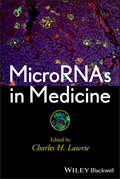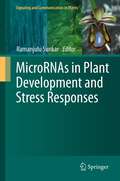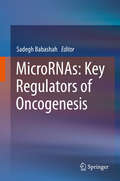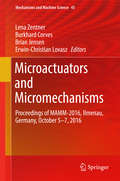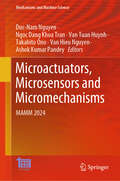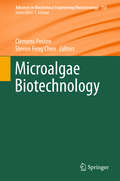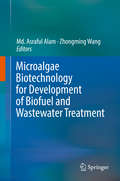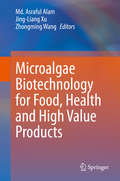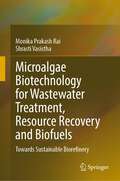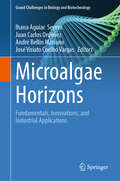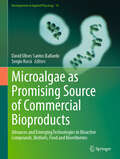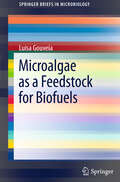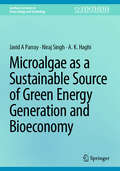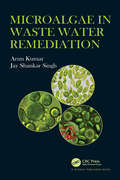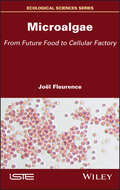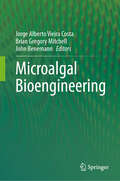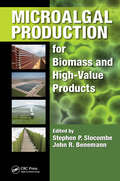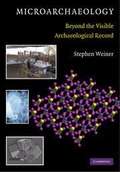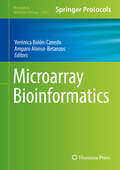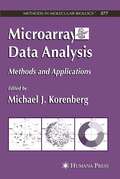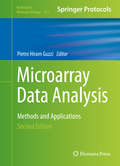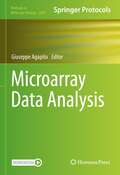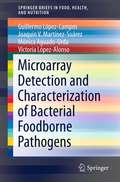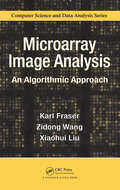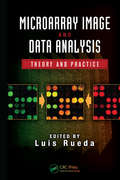- Table View
- List View
MicroRNAs in Medicine
by Charles H. LawrieMicroRNAs in Medicine provides an access point into the current literature on microRNA for both scientists and clinicians, with an up-to-date look at what is happening in the emerging field of microRNAs and their relevance to medicine. Each chapter is a comprehensive review, with descriptions of the latest microRNA research written by international leaders in their field. Opening with an introduction to what microRNAs are and how they function, the book goes on to explore the role of microRNAs in normal physiological functions, infectious diseases, non-infectious diseases, cancer, circulating microRNAs as non-invasive biomarkers, and finally their potential as novel therapeutics. Including background information on the field as well as reviews of the latest research breakthroughs, MicroRNAs in Medicine is a one-stop source of information to satisfy the specialists and non-specialists alike, appealing to students, researchers, and clinicians interested in understanding the potential of microRNAs in medicine and research.
MicroRNAs in Plant Development and Stress Responses
by Ramanjulu SunkarPrecise regulation of gene expression in both time and space is vital to plant growth, development and adaptation to biotic and abiotic stress conditions. This is achieved by multiple mechanisms, with perhaps the most important control being exerted at the level of transcription. However, with the recent discovery of microRNAs another ubiquitous mode of gene regulation that occurs at the post-transcriptional level has been identified. MicroRNAs can silence gene expression by targeting complementary or partially complementary mRNAs for degradation or translational inhibition. Recent studies have revealed that microRNAs play fundamental roles in plant growth and development, as well as in adaptation to biotic and abiotic stresses. This book highlights the roles of individual miRNAs that control and regulate diverse aspects of plant processes.
MicroRNAs: Key Regulators of Oncogenesis
by Sadegh BabashahAberrant expression and function of microRNAs (miRNAs) in cancer have added a new layer of complexity to the understanding of development and progression of the disease state. It has been demonstrated that miRNAs have a crucial function in oncogenesis by regulating cell proliferation and apoptosis as oncogenes or tumor suppressors. The expression signatures of miRNAs provide exciting opportunities in the diagnosis, prognosis and therapy of cancer. Since miRNAs can function as either oncogenes or tumor suppressor genes in oncogenesis, the potential of using these small RNAs as therapeutic targets opens up new opportunities for cancer therapy by either inhibiting or augmenting their activity.
Microactuators and Micromechanisms
by Burkhard Corves Erwin-Christian Lovasz Lena Zentner Brian JensenThis book presents a basic introduction to micromechanisms and microactuators, particularly to their basic configurations and design. This book fills the persisting gap in the published literature on the mechanical manipulative aspects of micromechanisms. It also helps in offering specialized introductory courses on micromechanisms and microactuators not as part of MEMS sensing devices, but as mechanical manipulative systems. The level of the book is suitable for use in both undergraduate and introductory graduate programmes. The book presents an overview of miniaturization and scaling laws, basic design principles of micro-sized mechanisms and actuators, micro-fabrication processes, and some futuristic issues. The volume contains a large number of figures and illustrations for easy understanding by the readers. It will also be useful to researchers and professionals looking for an introduction to the topic.
Microactuators, Microsensors and Micromechanisms: MAMM 2024 (Mechanisms and Machine Science #177)
by Takahito Ono Ashok Kumar Pandey Duc-Nam Nguyen Ngoc Dang Khoa Tran Van Tuan Huynh Van Hieu NguyenThis book brings together investigations which combine theoretical and experimental results related to such systems as flexure hinges and compliant mechanisms for precision applications, the non-linear analytical modeling of compliant mechanisms, mechanical systems using compliance as a bipedal robot and reconfigurable tensegrity systems and micro-electro-mechanical systems (MEMS) as energy efficient micro-robots, microscale force compensation, magnetoelectric micro-sensors, acoustical actuators and the wafer bonding as a key technology for the MEMS fabrication. The book gathers the contributions presented at the 7th Conference on Microactuators, Microsensors and Micromechanisms (MAMM), held in Ho Chi Minh City, Vietnam, in November 2024. The aim of the conference was to provide a special opportunity for a know-how exchange and collaboration in various disciplines concerning systems pertaining to micro-technology. The conference was organized under the patronage of International Federation for the Promotion of Mechanism and Machine Science (IFToMM).
Microalgae Biotechnology
by Clemens Posten Steven Feng ChenAntenna Mutants, Domestication, by Roberto Bassi Heterotrophic Cultivation, by William McCaffrey Chlorella for industrial applications: Advances and prospective, by Feng Chen Carotinoide, by Carola Griehl Engineering the algal chloroplast for synthesis of therapeutic proteins, by Saul Purton Design Concepts and recent developments of photobioreactors, by Clemens Posten Efficiency of flat plate reactors, by Mario Tredici Measuring modelling and control, by Olivier Bernard Microalgae in Life Support Systems, by Klaus Slenzka Heterotrophic oil production, by Makato Watanabe
Microalgae Biotechnology for Development of Biofuel and Wastewater Treatment
by Md. Asraful Alam Zhongming WangThis book addresses microalgae, which represent a very promising biomass resource for wastewater treatment and producing biofuels. Accordingly, microalgae are also an expanding sector in biofuels and wastewater treatment, as can be seen in several high-profile start-ups from around the globe, including Solix Biofuels, Craig Venter’s Synthetic Genomics, PetroSun, Chevron Corporation, ENN Group etc. In addition, a number of recent studies and patent applications have confirmed the value of modern microalgae for biofuels production and wastewater treatment systems. However, substantial inconsistencies have been observed in terms of system boundaries, scope, the cultivation of microalgae and oil extraction systems, production costs and economic viability, cost-lowering components, etc. Moreover, the downstream technologies and core principles involved in liquid fuel extraction from microalgae cells are still in their early stages, and not always adequate for industrial production. Accordingly, multilateral co-operation between universities, research institutes, governments, stakeholders and researchers is called for in order to make microalgae biofuels economical. Responding to this challenge, the book begins with a general introduction to microalgae and the algae industry, and subsequently discusses all major aspects of microalgal biotechnology, from strain isolation and robust strain development, to biofuel development, refinement and wastewater treatment.
Microalgae Biotechnology for Food, Health and High Value Products
by Md. Asraful Alam Zhongming Wang Jing-Liang Xu"Microalgae Biotechnology for Food, Health and High Value Products” presents the latest technological innovations in microalgae production, market status of algal biomass-based products, and future prospects for microalgal applications. It provides stimulating overviews from different perspectives of application that demonstrate how rapidly the commercial production of microalgae-based food, health and high value products is advancing. It also addresses a range of open questions and challenges in this field. The book highlights the latest advances of interest to those already working in the field, while providing a comprehensive overview for those readers just beginning to learn about the promise of microalgae as a sustainable source of both specialty and commercial products. It offers a valuable asset for commercial algae producers, algae product developers, scientific researchers and students who are dedicated to the advancement of microalgae biotechnology for applications in health, diet, nutrition, cosmetics, biomaterials etc.
Microalgae Biotechnology for Wastewater Treatment, Resource Recovery and Biofuels: Towards Sustainable Biorefinery
by Monika Prakash Rai Shrasti VasisthaThis book is designed with the objective of studying microalgae and its application in the widest sense. Microalgae offer various inherent advantages as they are capable of accumulating lipids (20–70%), and able to aid with the production of pigments, carbohydrates, and proteins. The book comprehensively covers microalgae isolation techniques, their cultivation, and wastewater treatment by microalgae as well as the impact on biomass, lipid extraction, biofuel, and utilization of residual biomass focusing on biorefinery approach. The volume discusses the conversion of defatted oiled microalgae biomass for different applications. Acknowledging these challenges, this book discusses the limitations, outcomes, and economic aspects
Microalgae Horizons: Fundamentals, Innovations, and Industrial Applications (Grand Challenges in Biology and Biotechnology)
by Ihana Aguiar Severo Juan Carlos Ordóñez André Bellin Mariano José Viriato Coelho VargasThis book provides comprehensive recommendations and insights into the fundamentals, innovations, and industrial applications of microalgae-based processes. Covering both upstream and downstream processes, it addresses challenges and solutions in scaling up microalgae technologies from laboratory to industrial uses. Key topics include cultivation techniques, bioreactor designs, harvesting and drying methods, and applications in food, biofuels, and environmental management. Special emphasis is placed on market trends, socio-political factors, regulatory frameworks, innovation, and sustainability, ensuring a holistic understanding of this rapidly evolving field. In addition, the final chapters are dedicated to real-world cases, highlighting pilot projects and large-scale installations that tackle practical challenges in engineering and commercialization. As an interdisciplinary science, microalgae technology has significant relevance in academia, industry, and government, driving innovation and contributing to a growing billion-dollar global market for high-value products. This book serves as an essential resource for students, researchers, scientists, engineers, and professionals seeking to deepen their knowledge and stay updated on the latest developments in microalgae research and applications.
Microalgae as Promising Source of Commercial Bioproducts: Advances and Emerging Technologies in Bioactive Compounds, Biofuels, Food and Biorefineries (Developments in Applied Phycology #14)
by Sergio Rossi David Ulises Santos BallardoThis book contains a wide compendium of information, which includes algal culture basics and the newest scientific and industrial advances in microalgal applications, including traditional uses such as renewable energy biofuels, wastewater treatment, edible products, aquaculture and livestock production. It also presents emerging perspectives of microalgae valorization, for example, health/cosmetic products, biofertilizers, bioplastics, vaccine delivery systems, nanotechnology and enzymes bio-factories. Moreover, this book provides a comprehensive overview for those readers that are initiating the study about microalgae potential as a renewable source of valuable commercial products and highlights the state-of-the-art on the innovative advances for scientific researchers, students and microalgae commercial producers, which already focused in developing microalgae biotechnology for bioenergy, food, and other applications. Also, the role of microalgae technology in the blue economy is analyzed, an aspect with high relevance in the present and the future time, but which is regularly understudied.
Microalgae as a Feedstock for Biofuels
by Luisa GouveiaThis Brief provides a concise review of the potential use of microalgae for biofuel production. The following topics are highlighted: the advantages of microalgae over conventional biofuel-producing crops; technological processes for energy production using microalgae; microalgal biomass production systems, production rates and costs; algae cultivation strategies and main culture parameters; biomass harvesting technologies and cell disruption; CO2 sequestration; life cycle analysis; and algal biorefinery strategies. The conclusions section discusses the contribution of the technologies described to environmental sustainability and future prospects.
Microalgae as a Sustainable Source of Green Energy Generation and Bioeconomy (Synthesis Lectures on Green Energy and Technology)
by A. K. Haghi Javid A Parray Niraj SinghThe primary focus of the topic is on the production of energy. Here, energy production typically refers to the conversion of waste algal biomass into various forms of usable energy. This could include electricity, biofuels (e.g., biodiesel, bioethanol), biogas, or other forms of renewable energy. Conversion of algal biomass to fuels via extraction of lipids (and potentially other components), through 'algal lipid upgrading' or ALU pathway, combined algal process (CAP) and parallel algal process (PAP). ALU approach based on a biochemical processing strategy to selectively recover and convert select algal biomass components to fuels, namely carbohydrates to ethanol and lipids to a renewable diesel blendstock (RDB) product. The scope of the topic encompasses the various methods and technologies used to convert waste algal biomass into energy. This could involve processes like anaerobic digestion, fermentation, pyrolysis, hydrothermal liquefaction, or other innovative techniques. The topic may touch upon ongoing research, technological advancements, and potential areas of improvement related to waste algal biomass-based energy production.
Microalgae in Waste Water Remediation
by Jay Shankar Singh Arun KumarMicroalgae in Waste Water Remediation aims to point out trends and current topics concerning the use of microalgae in wastewater treatment and to identify potential paths for future research regarding microalgaebased bioremediation. To achieve this goal, the book also assessing and analyzes the topics that attract attention among the scientific community and their evolution through time. This book will be useful to the students, scientists and policy makers concerned with the microalgae mediated management of wastewater effluents and its applications in overall future sustainable development.
Microalgae: From Future Food to Cellular Factory
by Joel FleurenceMicroalgae and cyanobacteria are the first organisms in the oceanic food chain and are essential producers of oxygen and effective carbon dioxide traps. They are traditional sources of food proteins for Aztec, African and Asian populations, and some of them have even acquired the status of superfoods. Microalgae reviews the biological, ecological and biochemical characteristics of microalgae and cyanobacteria. They are true cellular factories, producing substances of interest such as original pigments, proteins and polysaccharides with biological activities. Their use covers many sectors of human activity including aquaculture, livestock breeding, agri-food, and human and veterinary medicine.This book presents their mode of production and the transformation processes that are applied to them, as well as the traditional and future valorization of algae. As they are a source of lipids and fatty acids, microalgae have become the focus of attention for the development of green fuels, such as biofuel.
Microalgal Bioengineering
by Jorge Alberto Vieira Costa Brian Gregory Mitchell John BenemannThis book presents recent advances, challenges, and trends in modern microalgal biotechnology. It covers microalgae genetics, bioreactors, modeling, massive scale and industrial cultivation, and environmental, social, and economic aspects of microalgal biotechnology. The book also explores the emerging knowledge about high-value bioproducts from microalgae, e.g., biofuels, biosurfactants, bioremediation, bioplastics/biopolymers, pharmaceuticals, antioxidants (anti-aging), fatty acids, polysaccharides and proteins, feed and superfoods with microalgae. The chapters will be written by prominent professors and researchers from the six inhabited continents of the world, from academic to industrial sectors.
Microalgal Production for Biomass and High-Value Products
by Stephen P. Slocombe John R. BenemannMicroalgae are a particularly interesting source of products that range from currently marketed human nutritionals and food ingredients, to potential sources of biofuels and animal feeds. Rapid advances in technology and commercial development are taking place worldwide. Importantly, algal cultivation does not compete with agriculture for land, water, and in some cases, fertilizer resources. Microalgal Production for Biomass and High-Value Products covers the field from a variety of perspectives with 14 chapters contributed by recognized academic experts and industrial practitioners. The book presents the latest technologies and innovations in algal biomass production, from cultivation in open ponds and photobioreactors, to strain selection, synthetic biology, pest control, harvesting, and processing. It explores novel algal products and addresses key issues, including markets, supply chains, business strategies, legal issues, current products, and future prospects. This book brings together the latest advances of interest to those already working in the field while providing an introduction to those beginning to learn about the promise of microalgae as a sustainable source of both specialty and commodity products. It gives stimulating overviews from many different perspectives that describe how laboratory and applied research are creating advances in commercial microalgae production. It also addresses the still many open questions and challenges in this field.
Microarchaeology: Beyond the Visible Archaeological Record
by Stephen WeinerThe archaeological record is a combination of what is seen by eye, as well as the microscopic record revealed with the help of instrumentation. The information embedded in the microscopic record can significantly add to our understanding of past human behaviour, provided this information has not been altered by the passage of time. Microarchaeology seeks to understand the microscopic record in terms of the type of information embedded in this record, the materials in which this information resides, and the conditions under which a reliable signal can be extracted. This book highlights the concepts needed to extract information from the microscopic record. Intended for all archaeologists and archaeological scientists, it will be of particular interest to students who have some background in the natural sciences as well as archaeology.
Microarray Bioinformatics (Methods in Molecular Biology #1986)
by Amparo Alonso-Betanzos Verónica Bolón-CanedoThis book provides a comprehensive, interdisciplinary collection of the main, up-to-date methods, tools, and techniques for microarray data analysis, covering the necessary steps for the acquisition of the data, its preprocessing, and its posterior analysis. Featuring perspectives from biology, computer science, and statistics, the volume explores machine learning methods such as clustering, feature selection, classification, data normalization, and missing value imputation, as well as the statistical analysis of the data and the most popular computer tools to analyze microarray data. Written for the highly successful Methods in Molecular Biology series, chapters include the kind of detailed implementation advice that will aid researchers in getting successful results. Cutting-edge and authoritative, Microarray Bioinformatics serves as an ideal guide for researchers and graduate students in bioinformatics, with basic knowledge in biology and computer science, and with a view to work with microarray datasets.
Microarray Data Analysis
by Michael J. KorenbergIn this new volume, renowned authors contribute fascinating, cutting-edge insights into microarray data analysis. Information on an array of topics is included in this innovative book including in-depth insights into presentations of genomic signal processing. Also detailed is the use of tiling arrays for large genomes analysis. The protocols follow the successful Methods in Molecular BiologyTM series format, offering step-by-step instructions, an introduction outlining the principles behind the technique, lists of the necessary equipment and reagents, and tips on troubleshooting and avoiding pitfalls.
Microarray Data Analysis
by Pietro Hiram GuzziThis volume covers a large area, from the description of methodologies for data analysis to the real application. Chapters focus on methodologies for preprocessing of microarray data, a survey of miRNA Data analysis, Cloud-based approaches, application of data mining techniques for data analysis, biclustering to query different datasets, web-based tool to analyze the evolution of miRNA clusters, application of biclustering to mine patterns of co-regulated genes ontologies, microarray and proteomic Data, Gene Regulatory Network Inference, Gene Regulatory Network methods, analysis of Mouse data for metabolomics studies, analysis of microRNA data in Multiple Myeloma, microarray data analysis in Gliobastomas, and microRNA data in Cardiogenesis. Written for the Methods in Molecular Biology series, chapters include introductions to their respective topics, lists of the necessary materials and reagents, step-by-step, readily reproducible laboratory protocols, and tips on troubleshooting and avoiding known pitfalls. Authoritative and practical, Microarray Data Analysis: Methods and Applications, Second Edition aims to ensure successful results in the further study of this vital field.
Microarray Data Analysis (Methods in Molecular Biology #2401)
by Giuseppe AgapitoThis meticulous book explores the leading methodologies, techniques, and tools for microarray data analysis, given the difficulty of harnessing the enormous amount of data. The book includes examples and code in R, requiring only an introductory computer science understanding, and the structure and the presentation of the chapters make it suitable for use in bioinformatics courses. Written for the highly successful Methods in Molecular Biology series, chapters include the kind of key detail and expert implementation advice that ensures successful results and reproducibility. Authoritative and practical, Microarray Data Analysis is an ideal guide for students or researchers who need to learn the main research topics and practitioners who continue to work with microarray datasets.
Microarray Detection and Characterization of Bacterial Foodborne Pathogens
by Mónica Aguado-Urda Guillermo López-Campos Joaquín V. Martínez-Suárez Victoria López-AlonsoThis is a review of recent advances on the use of DNA microarray for diagnosing foodborne pathogens. Rapid detection and characterization of foodborne pathogens is critical for food safety. Many relevant technologies have been intensively developed to date. DNA microarray technology offers a new way to food safety involving pathogen detection and characterization. DNA microarray can be used for detection and characterization of pathogens by analyzing hybridization patterns between capture probes and nucleic acids isolated from food samples or bacteria. It allows more rapid, accurate, and cost-effective detection of pathogens compared with traditional approaches of cultivation or immuno-assays. The application of DNA microarrays to different foodborne bacteria, such as Campylobacter, Salmonella, Listeria monocytogenes, or Shiga toxin producing Escherichia coli, will improve their rapid identification and characterization of their genetic traits (e.g., antimicrobial resistance, virulence). As bacterial foodborne diseases are posing more serious threats to public healthcare, development of rapid and accurate methods for pathogen detection and characterization is critical to their proper control at the earliest time.
Microarray Image Analysis: An Algorithmic Approach (Chapman & Hall/CRC Computer Science & Data Analysis)
by Karl Fraser Zidong Wang Xiaohui LiuTo harness the high-throughput potential of DNA microarray technology, it is crucial that the analysis stages of the process are decoupled from the requirements of operator assistance. Microarray Image Analysis: An Algorithmic Approach presents an automatic system for microarray image processing to make this decoupling a reality. The proposed syste
Microarray Image and Data Analysis: Theory and Practice (Digital Imaging and Computer Vision #8)
by Luis RuedaMicroarray Image and Data Analysis: Theory and Practice is a compilation of the latest and greatest microarray image and data analysis methods from the multidisciplinary international research community. Delivering a detailed discussion of the biological aspects and applications of microarrays, the book: Describes the key stages of image processing, gridding, segmentation, compression, quantification, and normalization Features cutting-edge approaches to clustering, biclustering, and the reconstruction of regulatory networks Covers different types of microarrays such as DNA, protein, tissue, and low- and high-density oligonucleotide arrays Examines the current state of various microarray technologies, including their availability and affordability Explains how data generated by microarray experiments are analyzed to obtain meaningful biological conclusions An essential reference for academia and industry, Microarray Image and Data Analysis: Theory and Practice provides readers with valuable tools and techniques that extend to a wide range of biological studies and microarray platforms.
